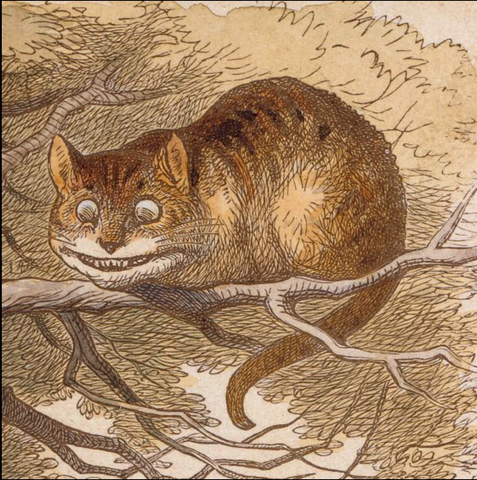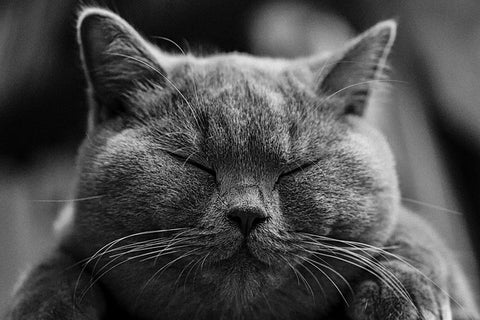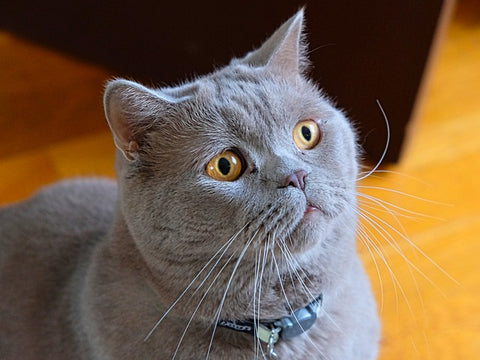The British Shorthair cat

How can you be unhappy when your cat is smiling at you?
Welcome a British Shorthair cat into your life, and you’ll probably find yourself smiling a lot more, too. The smile is contagious.
It’s also famous. This cat breed’s natural smiling appearance was the inspiration for artist John Tenniel’s famous rendition of the ever-smiling Cheshire Cat from the Alice in Wonderland stories.

But the smile is not the only thing that sets this special cat breed apart from all the others. This cat, one of the oldest breeds on the planet, has some other really eye-catching physical features, and some very unique personality traits, too.
The history of the British Shorthair cat

The British Shorthair has been living alongside humans since the first century. And yet, we almost lost them in the last. Twice.
Cats came to Great Britain some 2,000 years ago. We think they rode along with the Phoenicians, people from the eastern Mediterranean who were great maritime explorers.[1] But today’s British Shorthairs are more likely descendants of the cats that traveled with the Romans. Roman armies smuggled cats out of Egypt and then took them with them as they conquered their way through Europe. Cats were handy for keeping Roman camps and ships clear of snakes, mice, and other vermin.
The Romans left, but the cats stayed

Eventually, the conquerors were conquered themselves. The Romans may have gotten themselves kicked out of Great Britain, but the cats got to stay. They weren’t the British Shorthairs we know yet, though. They were common street cats called European Shorthairs that were probably closer in appearance to the Egyptian cats that were their forebears.
These cats were long and elegant, with sandy-brown, yellowy-gray tabby-marked or “ticked” coats. (A “ticked” or “agouti” coat means that each individual hair is striped, even if the cat isn’t striped.) They looked a lot like their African wildcat felis silvestris lybica ancestors.
After they spent some time in Europe, the European Shorthairs got friendly with their European wildcat felis silvestris silvestris neighbors. The European wildcat has a broad head, small, wide-set ears, a sturdy, muscular body, and short, thick fur. Sound familiar?
So, the British Shorthair evolved into a cat with a stocky body, and thicker, water-repelling coats to enable it to thrive in the colder, wetter conditions in Europe. These cats earned their place in British society by keeping the rodent population under control in barns, gardens, granaries, and alleyways.
Victorians loved their British Shorthairs
By the Victorian era, people started noticing that these alley cats were not just useful, but beautiful, too. They began to appreciate their personalities and their value as pets. The British Shorthair was shown at the first cat show in England, thanks to organizer Harrison Weir, an artist by trade, who is considered to be the “Father of Cat Fancy.” His 14-year-old female blue tabby British Shorthair won Best in Show.[2]
British Shorthairs become rare after World War I
By the early 1900s, Persians and other longhaired breeds captured the fancy of cat lovers, and the British Shorthair fell out of favor. Cat fancy altogether took a backseat to World War I. By the time the war was over, there were few worthy British Shorthairs left to breed. Breeders tried to “save” the British Shorthair by breeding the remaining cats with other cat breeds, which made them ineligible to be registered as British Shorthairs. It was a mess.
World War II devasted the British Shorthair again
A group of dedicated breeders worked hard to properly breed the remaining true British Shorthairs to keep this special breed going. But then World War II hit. The cats fell victim to the same food shortages that were affecting humans during this terrible time. Many cat breeders were unable to feed their cats. Once again, the British Shorthair was tottering on the edge of extinction.
It took many generations and considerable effort to preserve the breed for the second time. For genetic diversity, they had no choice but to outcross with other breeds, such as Russian Blues, Persians, French Chartreaux, and Burmese. The goal, which was achieved, was to reach a point when the cats could once again be bred only with each other, without any outcrosses.
What does the British Shorthair look like?

The British Shorthair is all about roundness. She has a round head, and large, round, wide-set eyes. Her ears are rounded at the tops, her paws are round, and even her thick tail tapers to a rounded tip.
The British Shorthair is a compact, muscular, powerful-looking cat. His legs are short to medium in length, thickly boned and strong. His head is massive, and it rests on a thick, short neck. His face has a short nose, and large, round whisker pads, which give his face that smiling impression. He’s got medium-sized ears that are broad-based and set far apart.
The British Shorthair’s coat is one of her most unique features. It’s short and dense and firm to the touch. It’s not double-coated; it’s just a thick, plush pile of fur that separates over the cat’s body as she moves. One reputable veterinary source contends that the British Shorthair has more fur per square inch than any other cat breed.[3] It’s probably true.
There’s also a longhaired type, called – you guessed it – the British Longhair. It’s the result of a cross between British Shorthairs and Persians.

When people think of the British Shorthair, they usually imagine the “blue” color, which is really a dark, steely gray. But Brits come in other colors, too: white, black, cream, tabby, tortoiseshell, calico, and bi-color (which is white plus another color). Eye color depends upon coat color, but can be deep gold, copper, blue, or green.
The British Shorthair can be a big cat. Males are huge: nine to 17 pounds, but females are smaller, just seven to 12 pounds.
What is the personality of a British Shorthair?
The British Shorthair is a sweet cat: even-tempered, quiet, and undemanding. He is affectionate, but also independent. He is playful but not wild.

A Brit can be a little reticent at first, but once she gets to know you, she will trust you. She will become devoted to you – but not clingy – quietly following you from room to room without demanding too much of you.
A British Shorthair is not a lap cat. He’d rather sit beside you, or curl up at your feet, than cuddle on your lap. Sharon Chance of the Best of British Shorthair Cat Club, described it this way: “I always say that Shorthairs are ‘with you’ cats as opposed to ‘on you.’”[4]
British Shorthairs don’t really enjoy being picked up. They’ll endure it, because British Shorthairs are tolerant cats, but they’ll demonstrate their discomfort at being carried by stiffly extending their limbs as if they’re trying to put more space between themselves and you.[5]
These cats make great apartment cats. They’re not hyper nor destructive. They like to keep all four paws on the floor: you’ll not find yours balancing at the top of bookshelf.
They’re also quiet: another advantage for apartment dwellers. Most Brits make tiny squeaking sounds rather than full-blown meows. But they’re famous for their robust, motor-like purrs.

Brits may not be wild, but they do have an incredibly powerful prey response, probably a holdover from their hunting days. They love games involving things they can chase or catch – the fishing-rod toy is the perfect toy for interactive play with a British Shorthair.
British Shorthairs make great family cats. They don’t tend to cling to one person, but rather, are loyal to the entire family. They’re patient and relaxed with children and have no tendency toward aggression. If the kids get too hands-on, these cats are more likely to make a quick, dignified exit, than to lash out or nip. That being said, children should be taught how to respectfully interact with any pet.
Speaking of which, British Shorthairs tend to get along well with other household pets, including dogs. But given their strong prey drive it’s best to keep small animals, such as hamsters or rabbits, out of reach. A British Shorthair is not above toppling a fish bowl, either.
In general, female British Shorthairs have more serious demeanors, while males are more lighthearted.[6] Both sexes are playful as kittens but begin to slow down after their first year of life, even though this slow-to-mature breed isn’t fully grown until up to 5 years old.[7]
How healthy is a British Shorthair?
The British Shorthair is a healthy, long-lived cat. If all goes as planned, yours will have a life expectancy of 14-20 years.[8] Just be sure to watch your Brit’s weight. This is a cat who likes to eat, and so easily puts on the ounces. Extra weight is a serious health risk for cats.

British Shorthairs are also prone to hypertrophic cardiomyopathy (HCM), the most common form of heart disease in cats. This disease causes a thickening of the heart muscle. If you are purchasing a kitten from a breeder, understand that there is no such thing as “HCM-free” bloodlines – don’t believe a breeder who tells you otherwise. No one can guarantee that a cat will not develop HCM.
British Shorthairs are also prone to a disease called hemophilia B, a hereditary bleeding disorder. There is a DNA test that allows breeders to identify carriers and affected cats.
There are two other health problems associated with this breed of cat. Polycystic kidney disease, in which a cyst forms in the cat’s kidney leading to organ failure, is one. This disease can be detected through genetic testing or ultrasound. There isn’t a cure but there is treatment. Fortunately, the prevalence of this disease in British Shorthairs appears to be on the wane. One study showed that currently fewer than 1% of British Shorthairs are carriers.[9]
British Shorthairs are also somewhat prone to hyperthyroidism, which is excessive thyroid hormone production. This disease affects metabolism and nearly all of a cat’s organs, especially the heart. Luckily, cats with hyperthyroidism can be treated with surgery and medication.
How easy is it to care for a British Shorthair?

A British Shorthair's plush coat is easy to groom with weekly brushing or combing to remove dead hair and distribute skin oils. Brush him more often in the spring and fall when he sheds his coat. Comb longhaired Brits daily to keep matting and tangles to a minimum.
Otherwise, a Brit only needs the kind of care that every other cat needs: nails trimmed with a good nail clipper, and teeth brushed with a good toothbrush and pet-friendly paste. Check their ears for redness or a bad smell that could indicate infection. Periodically wipe their ears with a cotton ball dipped in a gentle ear cleanser.
Are there any famous British Shorthairs?
Why, yes, there are! Here are some famous British Shorthairs you may know and already love:
- Smokey the cat in EB White’s children’s novel, Stuart Little
- The mascot of the Whiskas brand (it’s a silver tabby British Shorthair)
- Church, from the movie Pet Semetary
- Arlene in Garfield the Movie is portrayed as a British blue
If you enjoyed this post, read, The American Shorthair Cat. You might also like reading about How to choose a kitten from a litter.
Love Pinterest? Here's a Pinterest-friendly pin for your boards!

Dawn LaFontaine is a lifelong animal lover who always seems to have a little pet hair in her keyboard. Her blog, Kitty Contemplations, helps cat guardians better understand and care for the special beings they share their lives and homes with. Her cat-products business, Cat in the Box, sells beautiful, well-made, and award-winning products that she designed to meet the biological needs of cats.
_______________
FOOTNOTES
[1] “Phoenicia.” Wikipedia, https://en.wikipedia.org/wiki/Phoenicia.
[2] “The British Shorthair.” The Cat Fanciers Association Inc, cfa.org/british-shorthair/british-shorthair-article-1995/.
[3] “British Shorthair.” vca_corporate, vcahospitals.com/know-your-pet/cat-breeds/british-shorthair.
[4] “Breed Information.” USA British Shorthair, 12 May 2021.
[5] “British Shorthair.” Petfinder, www.petfinder.com/cat-breeds/british-shorthair/.
[6] “British Shorthair Cat Breed Information.” Vetstreet, www.vetstreet.com/cats/british-shorthair#1.
[7] Jacobs, Dana. “The British Shorthair.” The Cat Fanciers Association Inc, 1995, cfa.org/british-shorthair/british-shorthair-article-1995/.
[8] “British Shorthair.” Wikipedia, Wikimedia Foundation, 19 May 2021, en.wikipedia.org/wiki/British_Shorthair.
[9] Wikipedia


6 comments
Thanks very interesting article. I am a cat lover ! I have 7 all were feral and I trapped them ad tamed them . All interesting abd loving ! The Brits are beautiful!
Deborah – Thanks for saying so! They are special cats and you are very lucky to share your life with one.
I have a British Shorthair & thought I knew quite a bit. However, your article told me things I didn’t know. I thank you for that.